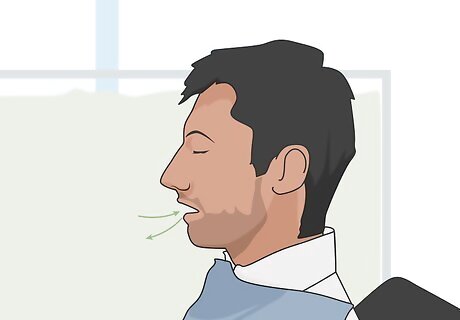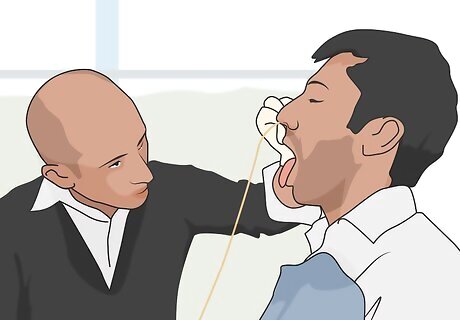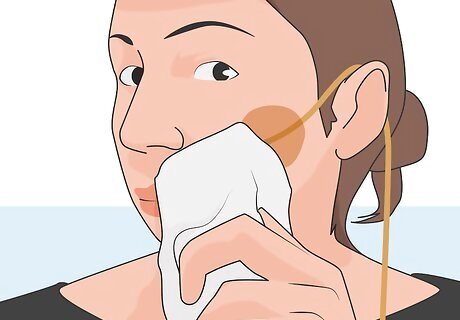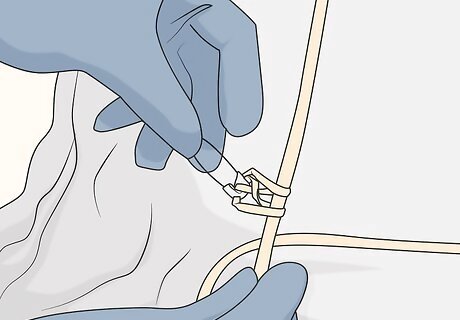
views
Ensuring a Comfortable Insertion

Let your doctor know if you have any history of nasal injury. Sometimes, one nostril may be better than the other for inserting an NG tube comfortably. If you have a deviated septum, previous nose injury, or any other conditions that might make it difficult to place the tube, let the doctor or nurse know, since this can help them determine which nostril will work best. For example, you might say, “I know I have some nasal polyps in my right nostril, so can we try using the left instead?” Before inserting the tube, they might close each of your nostrils one at a time and ask you to sniff. This will help them figure out which nostril has a wider or clearer airway.

Ask about anesthesia or sedation to reduce discomfort. There’s no getting around the fact that getting an NG tube placed is uncomfortable. Fortunately, though, there are medications that can make it easier. If you’re worried about pain and discomfort, ask if you can have a little lidocaine to numb the inside of your nose and throat. You can also ask for sedation, which can help you feel calmer and make you less likely to gag while the tube is going in. If your doctor or nurse gives you lidocaine, they might give it to you as a vapor through a mask. Alternatively, they might squirt it into your nose in liquid form, then ask you to snort it into your throat and swallow it. It may take up to 20 minutes for the anesthetic to fully take effect, so you may need to wait a little while between taking the lidocaine or sedative and having the tube put in. A local anesthetic spray can also minimize gagging, which many patients say is the most uncomfortable part of the procedure.

Agree on a signal to let the doctor know if you’re in distress. Before your doctor or nurse puts in the tube, work out a signal or gesture you can use if you get scared or feel really uncomfortable during the insertion. That way, if they see the signal, they’ll know to pause what they’re doing and try again after you’ve had a moment to rest and calm down. For example, you might raise your hand or tap on the armrest of your bed or chair.

Talk to your doctor about curling and lubricating the tube. Before inserting the tube, your doctor or nurse should curve the tube around their fingers to help it follow the natural curve of your nasal passages and throat. They may also lubricate it with a bit of water-soluble lubricant to help it slide in more smoothly. Don’t be afraid to speak up if you have any questions about how the tube is being prepared.Tip: Some patients find that a narrower, more flexible tube is more comfortable than the standard NG tube. If you’re having a lot of trouble with the insertion, consider asking the doctor for a smaller tube, such as a pediatric NG tube or a nasointestinal tube. For example, you could say, “Are you going to do anything to lubricate the tube before you put it in?” Some doctors recommend placing the end of the tube in an oral airway device and soaking it in an ice bath for several minutes to help it stiffen into a curved position. Alternatively, they might soak the tube in warm water to make it more flexible and soft.

Request water to sip during the insertion process. If you’re able to drink fluids, ask if you can have a cup of water and a straw. The act of swallowing the water will help draw the tube down your esophagus and into your stomach, and it can make you less likely to cough and gag. If you’re not allowed to sip on fluids, do your best to “dry swallow” the tube as it moves through your nose and down into your throat.

Sit upright to make the insertion easier, if possible. It will be easier for the NG tube to pass through your nose and throat and into your stomach if you’re sitting at an angle between 45° and 90°. Let the doctor or nurse prop you up and put a pillow under your head and shoulders before they start the procedure.Getting an NG tube put in can be a messy process. It’s normal for your nose to run and for saliva or other fluids to come out of your mouth. Your doctor or nurse should put a towel on your chest and give you a basin and tissues to help clean up any messes. If you’re not able to sit upright for any reason, ask if they can turn you onto your side.

Tuck in your chin to help widen your throat. Just before the doctor or nurse begins inserting the tube, tilt your head forward slightly and tuck in your chin. This will help open up the entrance to your esophagus, which will make it easier for the tube to pass into your throat. At the same time, start breathing through your mouth, which will also help open the back of your throat.

Keep swallowing as the tube enters your throat. It’s totally normal to gag and cough when the tube enters your throat, but for many patients, this is the most uncomfortable part of the process. If this happens, take small sips of water or swallows of saliva as the tube is advancing down your throat. This should help pull the tube into your esophagus and minimize the gagging. If you keep coughing and gagging anyway, the nurse or doctor will likely stop the procedure to check if the tube has become curled up in the back of your mouth or is starting to go into your airways instead of your esophagus.
Caring for the NG Tube

Clean the area around the tube as needed with a washcloth and warm water. When you have an NG tube in, your nose may run more than usual. If you notice any fluids or crusts building up around the tube, gently wipe them away with a soft, clean cloth dampened with comfortably warm water. Cleaning the area can help prevent irritation and infections.

Rinse your mouth regularly to prevent dryness and irritation. Since the tube partially blocks your nose, it’s not unusual to start breathing through your mouth when the NG tube is in place. Plus, you likely won’t be able to drink fluids through your mouth. To keep your mouth and throat from feeling dry and irritated, ask if you can rinse your mouth occasionally with water or mouthwash. You might also be allowed to suck on some ice chips.Keep in mind: Even if you aren’t eating through your mouth, oral hygiene is still important to protect you from infections and discomfort. Ask your doctor about how to clean your teeth and tongue with a sponge brush while the tube is in place.

Keep the tube securely pinned in place to reduce nasal discomfort. If your NG tube keeps sliding around, it’s more likely to irritate or injure your skin and the inside of your nose and throat. Check the clips on your gown or clothing to make sure the tube is secure, and keep the tube taped firmly to your nose. If you’re in the hospital, let your doctor or nurse know if you think the tube is slipping or if the tape and clips are coming loose. They can help you secure it back in place.

Talk to your doctor about how often to change the tube’s location. A nasal tube can cause your skin to become sore and irritated over time, so your doctor might recommend repositioning it or switching nostrils occasionally. Work with your medical team to figure out how often the tube needs to be moved or replaced. For example, they might recommend slightly repositioning the tube once every 24 hours, or removing the tube and switching it to the other nostril every few days. Let your care team know if you start to feel a lot of soreness or discomfort in the meantime.

Wash your skin with soap and water before putting on new tape. If you need to replace the tape on your tube, make sure to carefully clean and dry your skin with mild soap and warm water first. This will help the tape stick better and prevent oils, dirt, and bacteria from being trapped underneath it. You might also find it helpful to put a thin dressing, such as DuoDERM, on your skin underneath the tube. This extra dressing can help prevent rubbing and discomfort. Ask your doctor to recommend an adhesive remover that’s safe for your skin if removing the old tapes causes irritation.



















Comments
0 comment